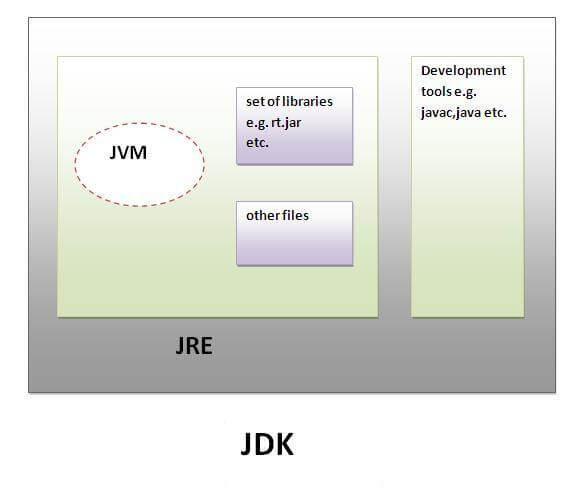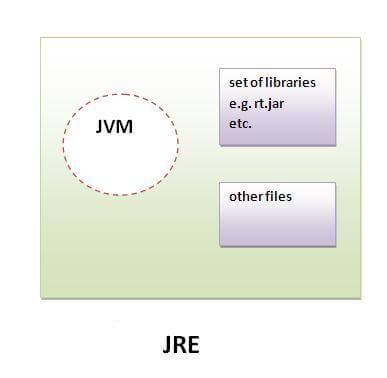JDK :
JDK stands for Java
Development Kit or sometimes it is also referred as Java Standard Edition Development Kit. JDK
is a development environment to develop wide range of applications such
as desktop applications, web applications or mobile applications using
Java programming language.

JRE :
Java Runtime Environment,JDK
stands for Java Development Kit or sometimes it is also referred as Java
Standard Edition Development Kit. JDK is a development environment to develop
wide range of applications such as desktop applications, web applications or
mobile applications using Java programming language.

|
JRE
(Java Runtime environment) |
JDK
(Java Development Kit) |
|
It is an implementation of the Java Virtual
Machine* which actually executes Java programs.
|
It is a bundle of software that you can use
to develop Java based applications.
|
|
Java Runtime Environment is a plug-in
needed for running java programs.
|
Java Development Kit is needed for
developing java applications.
|
|
The JRE is smaller than the JDK so it needs
less Disk space.
|
The JDK needs more Disk space as it
contains the JRE along with various development tools.
|
|
The JRE can be downloaded/supported freely
from
|
The JDK can be downloaded/supported freely
from
|
|
It includes the JVM , Core libraries and
other additional components to run applications and applets written in Java.
|
It includes the JRE, set of API classes,
Java compiler, Webstart and additional files needed to write Java applets and
applications.
|
JDK is created for Java
programmers, and contains tools required for Java programming,
e.g. javac for compiling Java source files to .class files. Without JDK, you can not create Java
applications and programs. By the way JDK comes with it's own JRE, but when you
run Java program using javacommand, the JRE which comes first in System PATH is used for execution. One of the
important thing to know is that, you can not run Java program from your machine
if you don't have either JRE or JDK. You can also consider JDK as super set,
which also contains JRE. For a normal user, installing JDK is overkill.

JDK
(Java Development Kit)
Java Development
Kit (JDK) is a bundle of software components that is used to develop Java based
applications. JDK is an implementation of either of Java SE, Java EE or Java
ME. Usually, learners start from JDK implementation of Java SE to learn core
Java features, which is also known as Java SDK. JDK includes the JRE, set of
API classes, Java compiler, Webstart and additional files needed to write Java
applets and applications. Java Development Kit is a bundle of the following
software components that are needed to develop Java based applications.
§ Java Compiler:
There are two ways
to pass source code file names to
javac:
o For a small number
of source files, simply list the file names on the command line separated by
blank space. For example:
D:\JavaPrograms>javac SelectionSortDemo.java SequentialSearchDemo.java
o For a large number
of source files, list the file names in a file, separated by blanks or line
breaks. Then use the list file name on the
javac command line,
preceded by an @ character. For an example, store three source file namesSelectionSortDemo.java, SequentialSearchDemo.java,SystemOutPrintlnDemo.java in
a file named source-file-list and then supply following
command in order to compile the source code files stored in source-file-list.D:\JavaPrograms>javac @source-file-list
Inner class
definitions produce additional class files. These class files have names
combining the inner and outer class names, such as
MyClass$MyInnerClass.class
§ Java compiler
is javac tool located in /bin folder of the
JDK installation directory. The javac tool (accessed
using
javac command) reads class and interface
definitions, written in the Java programming language, and compiles them into
bytecode class files. It can also process annotations in Java source files and
classes.
§ Java Interpreter: Java
interpreter is used to interpret the
.class Java files
that have been compiled by Java compiler (javac). Java interpreter
is accessed usingjava command. The java command
starts a Java application. It does this by starting a Java runtime environment,
loading a specified class, and calling that class's main method.
The method must be
declared
public and static, it must not return any value, and
it must accept a String array as a parameter. The method declaration has the
following form:public
static void main(String[] args)
By default, the
first argument without an option is the name of the class to be called. A fully
qualified class name should be used. If the
-jar option is
specified, then the first non-option argument is the name of a JAR file
containing class and resource files for the application, with the startup class
indicated by the Main-Class manifest header.
The Java runtime
searches for the startup class, and other classes used, in three sets of
locations: the bootstrap class path, the installed extensions, and the user
class path.
Non-option
arguments after the class name or JAR file name are passed to the main
function.
§ Java Disassembler: The
javap command is
the disassembly tool of JDK that disassembles one or more class files. Its
output depends on the options used. If no options are used, javap prints out
the package, protected, and public fields and
methods of the classes passed to it. The javap prints its
output to stdout.
§ Java Header File
Generator: Java
Header File Generator (
javah command-line
tool) generates C header and source files that are needed to implement native
methods. The generated header and source files are used by C programs to
reference an object's instance variables from native source code. The .h file contains
a struct definition whose layout parallels the layout
of the corresponding class. The fields in the struct correspond to
instance variables in the class.
The name of the
header file and the structure declared within it are derived from the name of
the class. If the class passed to javah is inside a package, the package name
is prepended to both the header file name and the structure name. Underscores
(_) are used as name delimiters.
By default
javah creates a
header file for each class listed on the command line and puts the files in the
current directory. Use the -stubs option to
create source files. Use the -o option to
concatenate the results for all listed classes into a single file.
The new native
method interface, Java Native Interface (JNI), does not require header
information or stub files. The
javah tool can
still be used to generate native method function prototypes needed for
JNI-style native methods. Thejavah tool produces
JNI-style output by default, and places the result in the .hfile.
§ Java Documentation: Java
Documentation helps to maintain code. The
javadoc tool comes as
part of Java Development Kit that parses the declarations and documentation
comments in a set of Java source files and produces a corresponding set of HTML
pages describing (by default) the public and protected classes, nested classes
(but not anonymous inner classes), interfaces, constructors, methods, and
fields. You can use it to generate the API (Application Programming Interface)
documentation or the implementation documentation for a set of source files.
You can run
the
javadoc tool on entire packages, individual source
files, or both. When documenting entire packages, you can either use -subpackages for
traversing recursively down from a top-level directory, or pass in an explicit
list of package names. When documenting individual source files, you pass in a
list of source (.java) file names.
§ Java Debugger: The Java
Debugger,
jdb, is a simple command-line debugger for Java
classes. It is a demonstration of the Java Platform Debugger Architecturethat provides
inspection and debugging of a local or remote Java Virtual Machine.
§ Java Applet Viewer: This is used
to view the Java applets. The
appletviewercommand connects to
the documents or resources designated by urls and displays
each applet referenced by the documents in its own window. Note: if the
documents referred to by urls do not reference any applets
with the OBJECT, EMBED, or APPLET tag, then appletviewer does nothing.
For details on the HTML tags that appletviewer supports, see AppletViewer Tags.
JRE
(Java Runtime Environment)
JRE is an
implementation of the JVM which actually executes Java programs. It includes
the JVM, core libraries and other additional components to run applications and
applets written in Java. Java Runtime Environment is a must install on machine
in order to execute pre compiled Java Programs. JRE is smaller than the JDK so
it needs less disk space and it is so because JRE does not contain Java
compiler and other software tools needed to develop Java programs.
Difference
Between JRE and JDK
|
JRE
(Java Runtime environment)
|
JDK
(Java Development Kit)
|
|
JRE
is an implementation of the Java Virtual Machine which actually executes Java
programs.
|
JDK
is a bundle of software that is used to develop Java based applications.
|
|
Java
Runtime Environment is a plug-in needed for running Java programs.
|
Java
Development Kit is needed for developing Java applications.
|
|
JRE
is smaller than the JDK so it needs less disk space.
|
JDK
needs more disk space as it contains the JRE along with various development
tools.
|
|
JRE
includes the JVM, Core libraries and other additional components to run
applications and applets written in Java.
|
JDK
includes the JRE, set of API classes, Java compiler, Webstart and additional
files needed to write Java applets and applications.
|
No comments:
Post a Comment